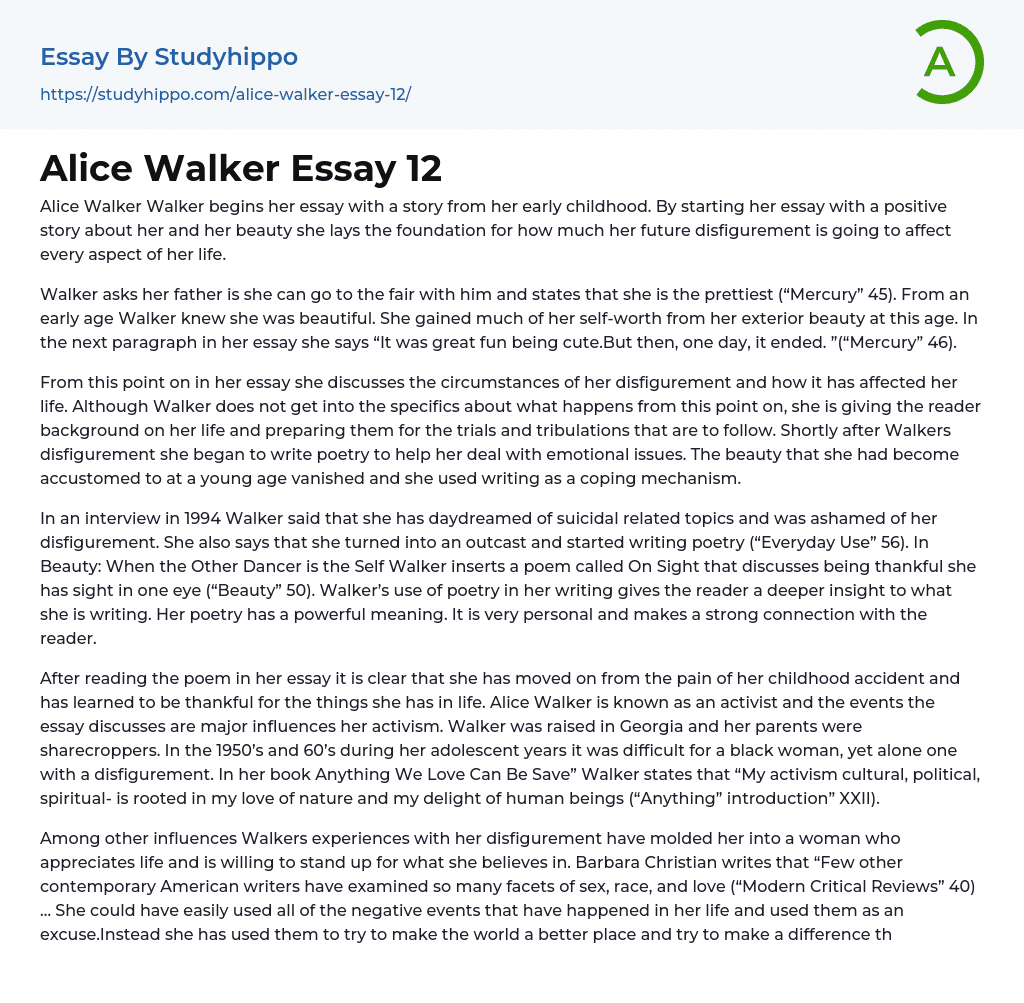Starting her essay, Alice Walker recalls a delightful memory from her youth that emphasizes her attractiveness. This beginning establishes the foundation for how all aspects of her life are affected by the disfigurement she experiences later on.
In her essay "Mercury," Walker acknowledges that she was aware of her physical appeal from a young age and drew much of her confidence from it. She even requested that her father accompany her to the fair, where she proclaimed herself as the most attractive. Nonetheless, as demonstrated in the ensuing paragraph, this pleasure ultimately waned.
Walker's essay explores the influence of her disfigurement on both her life and emotional well-being. Although she does not delve into specifics about what follows, she sets the stage for readers to understand the difficulties that lie ahe
...ad. Walker found solace in poetry as a means of coping with the loss of beauty that accompanied her disfigurement.
In 1994, Walker shared in an interview that she used to daydream about suicide and felt ashamed of her disfigurement. This caused her to become an outcast, but led her to take up poetry writing as depicted in "Everyday Use" (56). In her book, "Beauty: When the Other Dancer is the Self", she included a poem called "On Sight" where she expressed gratitude for having sight in one eye (50). Through her use of poetry, readers are able to gain a deeper understanding of Walker's work. The personal nature of her poems creates a strong connection with readers and conveys profound meaning.
It is apparent that the poet in the essay has moved beyond the trauma of her childhood injury and has developed gratitude for the blessings in he
life. Alice Walker, known for her activism, draws inspiration from events discussed in the essay. As a young girl raised in Georgia by sharecropping parents during the challenging 1950s and 60s, being both black and disfigured made life challenging for Walker. In her book, “Anything We Love Can Be Saved,” she writes that her activism, which spans cultural, political and spiritual spheres, is rooted in her love for nature and appreciation of human beings (“Anything” introduction” XXII).
Alice Walker's experiences with disfigurement have shaped her into a woman who values life and stands up for her beliefs. According to Barbara Christian, Walker is one of the few contemporary American writers who explores sex, race, and love from various perspectives ("Modern Critical Reviews" 40). Although she could have used the negative incidents in her life as an excuse, Walker has chosen to use them to make a positive impact on the world through her writing. Works Cited and Consulted: Bates, Gerri. Alice Walker: A Critical Companion.
The Color Purple, a novel by Alice Walker, was published by Harcourt, INC. in 1982. It is featured in the book Modern Critical Reviews: Alice Walker edited by Harold Bloom, which was published by Chelsea House in 1989. Another publication that mentions her work is Anything We Love Can Be Saved, while Greenwood Press released it in 2005 in Westport, Connecticut.
In 1997, "Beauty: When the Other Dancer is the Self" was published by Random House in New York. It is featured in the Mercury Reader, which was compiled by Scott Stankey and published by Pearson-Custom in Boston in 2007.
The article titled "Black Writer and the Southern Experience"
in Literary Cavalcade from November/December 2001, found on Academic Search Premier via EBSCOhost, covers pages 10 and beyond.The source "Everyday Use" by Barbara T. Christian can be found on the website http://web.ebscohost.com, which was accessed on February 28th, 2008 from Anoka Ramsey Community College in Coon Rapids. The information is presented within .The contain citations to two distinct sources. The first is a book called "Warrior Marks: Female Genital Mutilation and the Sexual Blinding of Women," which was released in 1993 by Harcourt Brace & Company in New York. The second source mentioned is an article titled "In Full Bloom," which examines a book published by Rutgers University Press in New Brunswick, New Jersey in 1994. Originally printed on September 20th, 2004 by The Nation, the article discusses this book.
- Book Summary essays
- Metaphor essays
- Reader essays
- Rhyme essays
- Literary devices essays
- Villain essays
- Books essays
- Genre essays
- Literary Criticism essays
- Writer essays
- Protagonist essays
- Simile essays
- Poem essays
- Book Report essays
- Book Review essays
- Greek Mythology essays
- Plot essays
- Tragic Hero essays
- Coming of Age essays
- Play essays
- Rhetoric essays
- Rhetorical Question essays
- Translation essays
- Understanding essays
- Reason essays
- Character essays
- Letter essays
- American Literature essays
- Literature Review essays
- Utopia essays
- Poetry Analysis essays
- Dante's Inferno essays
- Between The World and Me essays
- Incidents in The Life of a Slave Girl essays
- Flowers for Algernon essays
- Myth essays
- Everyday Use essays
- Boo Radley essays
- Genesis essays
- Richard iii essays
- Alice in Wonderland essays
- On the road essays
- Ozymandias essays
- The Nightingale essays
- Holden Caulfield essays
- Animal Farm essays
- 1984 essays
- A Hanging essays
- Shooting An Elephant essays
- A Tale Of Two Cities essays




